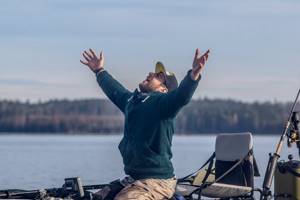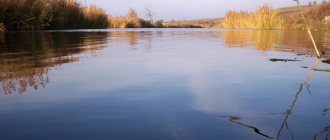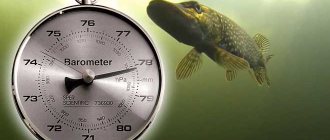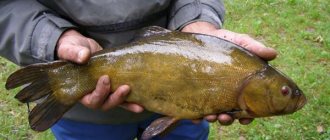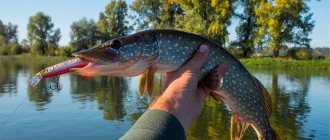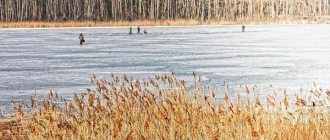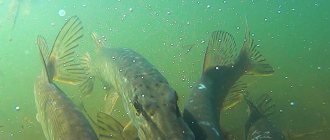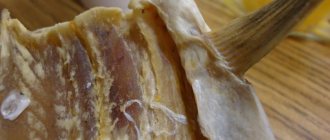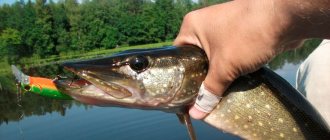Nature has no bad weather - a famous saying that has nothing to do with fishing. Even a novice fisherman knows that the fish bite is influenced by numerous factors - atmospheric pressure, rain and other types of precipitation, air and water temperature, wind strength and direction, phases of the moon and the migration season of fur seals.
Pike also do not always bite equally actively - the fisherman’s task is to constantly analyze, observe and put together bits of information in order to know what pressure, wind direction, as well as other weather factors are to the liking of the pike, and when, as they say: “June - go fishing spit” (it’s not true!).
All the information presented is not dogma, there are no rules without exceptions. Sometimes, in the heat of July in the middle of the day, a pike goes berserk and grabs a camera carelessly dropped into the water, and sometimes on a cloudy day with a light drizzle it is silent, like Gerasim over a mumu.
Correlation of weather phenomena and pike biting
So, experience shows that the following weather phenomena and events influence the pike bite:
- Season . Spring Summer Autumn.
- Time of day . Morning afternoon Evening Night.
- Atmospheric pressure (low, normal, high).
- Precipitation (rain, snow, hail).
- Wind strength and direction (calm, moderate breeze, strong wind, squall).
- Air temperature.
- Water temperature.
- Moon phases (lunar calendar for pike fishing).
- Water level, its transparency.
Almost all weather parameters that influence pike biting are closely related to the season of the year, therefore, taking into account the general principles, we will also start from the main factor - seasonality.
Pike fishing in spring
As a rule, the predator’s active biting begins in early April and continues until spawning, after which the spotted beauty gets sick for a couple of weeks, refusing the baits offered to her. When going fishing, you need to take into account the characteristics of the reservoirs. Flowing rivers come to life after winter freeze-up much faster than lakes and ponds. A spring day is changeable - in the morning it can pamper you with bright sunshine, which is suddenly replaced by gusty winds and pouring rain. At this time of year, the weather affects the comfort of fishing more than the fish bite. Pike responds well on sunny and cloudy days.
To learn more:
Rudd: description of fish and differences from roach
Atmospheric pressure plays a big role. Its sharp change causes the fish to fall into a stupor and close its mouth in front of wobblers and spoons. Live bait rigs have an advantage in such conditions. Instead of chasing colored bait, it is easier for a predator to feast on a wounded fish. A good pressure for pike fishing is considered to be the transition period from a high to a low value. In this situation, oxygen dissolved in water is concentrated more in the lower layers, where pike wait for prey.
Time of day: illumination, visibility in water, biorhythms
In summer, pike can be caught at the following times of day in descending order:
- morning dawn from the spruce tree is visible until the first rays of the sun;
- two hours after sunrise;
- evening - from 17 to 19;
- in the daytime - the more sun there is, the weaker the bite and vice versa;
- at night - rarely, but it happens, especially if the night is moonlit.
This gradation is associated with biorhythms - the predator fills its belly in the summer during those hours when the water is as cool as possible. In sunny days, you should look for it in the pits, although even there success is not guaranteed at this time - the somnambulist is resting.
At night, visibility is minimal, so the activity of pike also decreases; it is not a nocturnal predator, not burbot or catfish.
In spring and autumn, the time frame is blurred, the water is already cool, and zhor is observed - post-spawning and pre-freezing, respectively. Therefore, pike are caught throughout the day, activity depends on many factors, weather conditions are also important, but more on that later.
What weather is best to catch pike in summer?
Unlike in the spring, when the pike bite becomes more active, in the summer the pike catch is limited to short hunting trips. For example, in clear, hot weather you can catch small pike weighing up to 1 kg. The bite usually starts in the morning, until the sun starts to get hot or the wind starts to pick up. In hot weather, the predator bites rarely and reluctantly. Its activity increases significantly just before sunset and, as a rule, lasts no more than 1-2 hours.
If you choose cloudy weather for pike fishing, you can expect a good catch. Even in light rain there is a huge chance of catching a big trophy. This is due to the fact that rain naturally saturates the water with oxygen and makes its inhabitants more active.

Don't expect a good bite in windy, gusty weather. Under such conditions, making an accurate cast seems difficult. But if you choose heavy baits, you also have a chance to catch a toothy predator.
Optimal atmospheric pressure for pike fishing in spring, autumn and winter
Atmospheric pressure is measured in millimeters of mercury; the normal value is 760 mm at sea level. This pressure is considered normal, respectively, higher than this indicator is increased, lower - decreased.
With increased pressure, the pike rises to the surface of the reservoir, and with a decrease, it sinks to the bottom. This is due to the fact that when the pressure decreases, carbon dioxide and other harmful gases rise to the surface of the water. This is worth considering when fishing.
With low pressure, rain and wind are usually observed; on the contrary, an increase is accompanied by clear and sunny weather.
Note that the main axiom is that the stability of atmospheric pressure is important, and not its qualitative value. If the pressure does not change, or changes within 3-8 mm over several days, you can safely go fishing. But the races force the fish to change their usual way of life (change their parking place and depth, activity decreases due to a painful condition), due to the fact that the composition and density of the water changes.
From experience in catching striped predators, it can be noted that pike bite well at consistently low pressure in the region of 740-750 mm . A slight breeze from the west, south or south-west will be a plus. At high pressure (which means heat and heat), the predator does not take it, or takes it only at dawn.
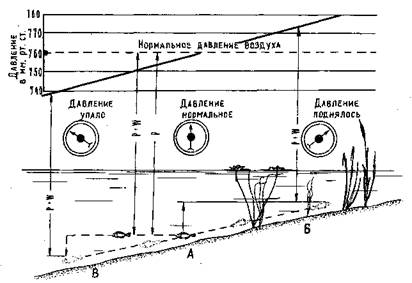
Migration of pike depending on atmospheric pressure
Thus, with stable pressure, pike bite at any time of the year; in summer they prefer a slightly lower pressure; in spring and autumn, on the contrary, a gradual increase - this clearly looks like an improvement in the weather.
Useful tips
- The behavior of pikes in different bodies of water varies and depends on local conditions. This also applies to the intensity of the bite. Therefore, for successful fishing it is worth studying the features of the reservoir.
- Any fish, including pike, adapts to the level of pressure , therefore, when high pressure lasts for several days, the pike switches to normal behavior and diet. And that means you can count on an active bite.
- At low pressure, small fish (potential prey for pike) are somewhat sluggish, so when fishing with a spinning rod, the retrieve should be slow, otherwise you can scare off the predator.
It should be remembered that pressure is far from the only factor influencing the success of pike fishing. But if you take into account all the nuances of the difficult task of catching a cunning predator, then under any pressure you can come home with prey.
Wind strength and direction
The breeze has a positive effect on the activity of pike. It raises ripples, this disorients the fish and makes it easier to deceive, plus the wind is often accompanied by a smooth decrease in pressure, which is a plus when fishing for catfish and striped fish.
The power of the gusts can even be significant; if there are no pressure surges, then this does not worsen the bite. Another point is that it is very difficult to fish in a strong squall, especially with a spinning rod.
In calm weather, the bite is usually not so active, although at dawn the opposite is true. The best weather at dawn is fog or light drizzle, calm or a light breeze.
The best wind directions are west, south and south-west without sudden changes in direction.
What kind of wind does pike bite in?
Like pressure, this indicator plays a role, but not the key one. The direction of the wind does not affect the activity of the fish as much as its strength. Based on the situation on the reservoir, you should choose a fishing spot in such a way that the wind blows from the back or from the side. If fishing is carried out from a boat, in case of strong gusts it makes sense to leave the clear water area, giving preference to shallow bays, covered on all sides by dense thickets of reeds. The southern wind direction is much more pleasant than the northern one, since the air flow does not penetrate clothes so much.
Moderate gusts of wind, up to 5 m/s, play into the hands of the fisherman, because due to the disturbance of the water surface, the water area is saturated with oxygen, which forces river inhabitants to behave actively. In bad weather, it is better to arm yourself with a heavier rod and equipment, since it will not be possible to correctly retrieve with light weight. Lures that are preferred in bad weather:
- oscillating spoons;
- silicone on heavy jig;
- large wobblers, jerks;
- rotating spoons with front loading.
Poppers should be immediately taken out of the fishing box, since fishing on waves is impossible with them. You should also leave a light rod at home with baits up to 3 inches
Precipitation - does pike bite in drizzle, rain, downpour?
It has been noticed that pike respond very readily to spinning baits in light, drizzling rain, which either intensifies or stops altogether. This is especially true in the summer - the air and water temperatures drop, and the pressure drops. This provokes the predator to become active and eat.
It is important to know! Before a thunderstorm in the summer, within 2-3 hours, there is very often an instant activation of zhora, which begins abruptly and ends just as abruptly. Don't miss this opportunity.
Freeze-up period
Winter is a new page for predator hunting lovers. The peculiarities of ice fishing force you to monitor weather reports, not only because it affects the activity of the fish, but for your own comfort on the ice. A frozen person does not enjoy the process of sparkling, but dreams of being at home, warm. The best time to hunt for pike is during the thaw. A little snowfall will also have a positive effect on the bite. Fishing with girders is possible even at low temperatures reaching -15-20°C. It is uncomfortable to operate a spinner in cold weather. The girders, which the fisherman watches from a warm tent, help out.
To learn more:
The best colors of spinners for pike fishing
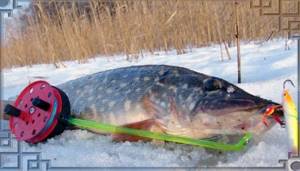
Water temperature
Pike does not tolerate extremes. Water boiling from the heat in the summer, or cold to zero in the winter - don’t expect a pike bite. In the June-August heat, the water warms up to its maximum and at this time it is worth looking for a predator in the pits, on the stream, in areas where several multidirectional currents collide and create the effect of an aerator - seething, oxygenated water.
It is also worth shifting the emphasis to catching pike at dawn, in rain and fog - in such weather there is more activity and the fish bite greedily.
In winter, in the dead of winter, it is usually impossible to lure a pike, but if the hunt is worse than captivity, you can try to look for places where the water is warmer and saturated with oxygen - dams, bridges, hydroelectric power stations.
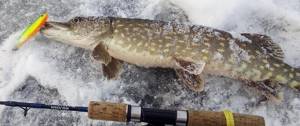
Pike in autumn, 5 secrets
The article talks about what you need to know in order for pike fishing in the fall to always be effective. There are 5 secrets!
At the end of October and beginning of November the first frosts occur. During this period, the water cools down very much, as a result of which the underwater vegetation freezes and lies in an even layer on the bottom of the reservoir, thereby opening up new areas for the angler to catch toothy predators. Many professional spinning anglers are looking forward to this gift of nature with great impatience, since they can begin to explore those areas that could not be fished throughout the summer due to underwater vegetation.
Let us note that other amateur fishermen who are accustomed to fishing with donks and float rods also try not to miss this moment. They put their usual gear aside and, armed with a spinning rod, go to small bays in search of perch and pike.
But not everyone is destined to return with a large and rich catch even during this period of time. There are several explanations for this.
Secret one
Pike really don't like sudden changes in temperature. Fish, as everyone knows, are cold-blooded, and due to a decrease in temperature, biological processes in its body immediately slow down, as a result of which its activity is significantly reduced.
During the cold season, pike are least active. Its main task, even during a hunt, is to spend as little effort and energy as possible. During the cold season, pike most of the time stands motionless in one place, waiting for the fry to swim by. Note that the size of the fry must be large so that the effort to jerk at the moment of attack is not wasted. In autumn, shallow lakes and eriks cool down at a rapid rate, as a result of which pike activity becomes dull. Based on this, it should be concluded that autumn pike in cold water should be looked for only in small areas and the coastal zone. In addition, it is important to correctly approach the issue related to the choice of artificial baits for pike fishing.
As practice shows, autumn pike begin to be caught best in the afternoon, this is worth remembering.
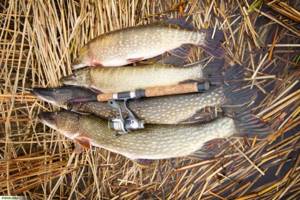
The second secret
Of course, the weather has a great influence on pike activity, to a greater extent this concerns illumination and atmospheric pressure. As it may seem, in calm sunny weather the pike should be most active, since the water warms up faster and the conditions in the reservoir become more favorable. However, this is not the case. Pike are most active in cloudy and rainy weather. This is explained by the fact that in autumn the degree of water transparency is quite high, and this negatively affects the comfort of pike. Therefore, in sunny weather, the predator tries to hide from the sun as quickly as possible and least of all thinks about hunting. It is also important to note that in sunny weather the atmospheric pressure is always high, which has a very negative effect on the activity of the predator. As for cloudy weather, the pressure is almost always low and, most importantly, stable, which in turn increases the degree of activity of the pike. In addition to these natural factors, the wind affects the pike bite. On days when there is no wind, the pike becomes more cautious and tries not to leave its ambush over trifles. However, the wind that blows from the east or north also has a negative effect on the bite. The best wind for pike fishing is one blowing from the southwest or south at a speed of no more than 7 m/s.
I advise you to read: How to find out what the weather will be like? — The article contains several ways to determine what the weather will be like the next day (or during the day).
Many anglers try to go fishing in sunny and calm weather, but in rainy weather they don’t even think about fishing and this is their biggest mistake. It is impossible to compare comfort for humans and comfort for fish, since these things are completely opposite, that is, what is good for humans is bad for fish.
The third secret
It is important to pay attention to the phase of the moon. There is an opinion that it does not affect the activity of pike, but this is not the correct opinion. We can say with confidence that the latter and the first contribute to an increase in fish activity.
The fourth secret
Correct choice of artificial bait. It is difficult to determine with confidence which bait will catch pike best, since this is influenced by many factors, such as the characteristics and conditions of the reservoir, time of day, weather conditions, and the fry that the pike feeds on in the reservoir. Therefore, when going to a pond, you need to have in your kit the largest possible range of artificial baits. It is believed that spinners and wobblers are the most catchy, but this does not mean that spinners and silicone can be put aside. The support of baits must be carried out taking into account the fishing location. As we have already said, in the fall pike prefers to stay shallow, and therefore the bait should be light. However, in no case should it be small, as this can lead to the fact that it will be most attacked by perch, and not by pike, which is the main target of fishing. To catch pike in the autumn, it is recommended to use baits the size of which is at least 12 cm. In addition, it is necessary to select baits that are capable of performing a good game even at a minimum fishing speed. As for the color, it doesn't matter much.
Secret fifth
Change the location as often as possible while fishing. You shouldn’t focus on one area, because if after 10-15 throws there is no pike attack, this can only mean that it is not there. By frequently changing your fishing location, there is a high probability that you will be ambushed by a pike.
Share with your friends!
Dependence on the time of year - seasonality of pike biting: a brief summary
Good cool weather for pike in spring
In spring, pike begin to actively feed before and after spawning 7-10 days later, usually in mid-April to early May. In reservoirs where there is no ban, it is worth trying to catch it with silver bait, due to the fact that the water is cloudy and dirty. You can often find it in heated areas of the reservoir - it is at this time that heated water is a plus.
Quiet days with a light wind from the south are good. Cloudy weather conditions are also working.
Spreaders, noisy minnow wobblers and crankbaits are good.
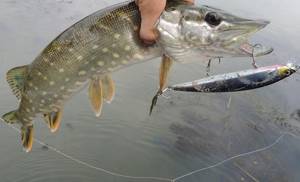
Summer time - what does the toothy one like in the heat?
In the heat of the day, fishing should be postponed until dawn - evening and especially morning. It’s good when the pressure is settled around 740 mm for the middle latitudes of Russia and the CIS.
If there is fog outside, cloudy and rainy weather without showers, or just the sky is overcast, then you can catch a predator throughout the daylight hours.
Lures - jigs, oscillating and rotating spoons, wobblers.
In the hottest sunshine we go to holes, edges and areas next to a fast current. We fish in the water column and near the bottom.
When is the best time for pike to bite in the fall - pressure, wind and other weather factors
In early autumn - mid-August-September, pike live in many respects according to the “rules” of summer time - they are active due to low pressure, and tend to feed on heavy rain and cool days.
Autumn October - November, when the average daily temperature drops below 15 degrees, is the time for the pre-spawning feast of pike, which no self-respecting spinning fisher will miss.
The best pressure for fishing in the fall is stable, slightly above normal or normal. Good fishing throughout daylight hours. There are usually several bursts of activity: 7-9 am, 15-17 pm and at sunset.
Winter suffering
In winter, pike bite well on the first ice. Particularly active during light snowfall and light frost. During snowstorms and blizzards, activity is weak. In the wilderness, it is worth looking for places saturated with oxygen - dams, bridges, ice holes, cracks in the ice.
The effect of pressure on pike biting
The pike's bite worsens during pressure changes. At times when it rises or falls, the fish poorly to baits or do not pay attention to them at all. In this case, anglers say that the pike is sick and cannot be caught. remains at the same for 2 or more days - remains low, medium or high - you can count on good catches.
With differences of 2-3 mm Hg, the activity of the pike decreases, but it continues to feed. The bite worsens as much as possible or stops altogether with more noticeable pressure drops.
THIS IS INTERESTING. Some believe that when the pressure increases, the pike moves to shallow areas, and when it decreases, it goes deeper, so after changes in this indicator, you need to look for fish in other points. But there is no clarity on this issue, since the opinions of fishermen differ.
Good conditions and good weather for pike fishing - throw and pull
There are days and even weeks when even an inexperienced fisherman with a minimum amount of knowledge and the simplest gear does not return home without a catch. What is an ideal day for a spinning angler - what weather is best to catch pike?
Situation one : Oxbow lake, 4-5 am, light fog on the water - the water is steaming, as fishermen like to say. Not a single petal moves on the hanging willows. It's plus 18 outside, a little chilly at dawn, the water cooled a little overnight. A crucian carp rubs near the water lilies. Turntables and minnow wobblers go into battle...
Situation two : Channel holes are at your feet, and a thunderstorm is brewing on the horizon, thunderstorm and threatening clouds are gathering one to the other. No more than an hour and a half until the first drops. It’s unbearably hot, but in a few tens of minutes everything will turn upside down. There's a jig on the line, a trophy in the head...
